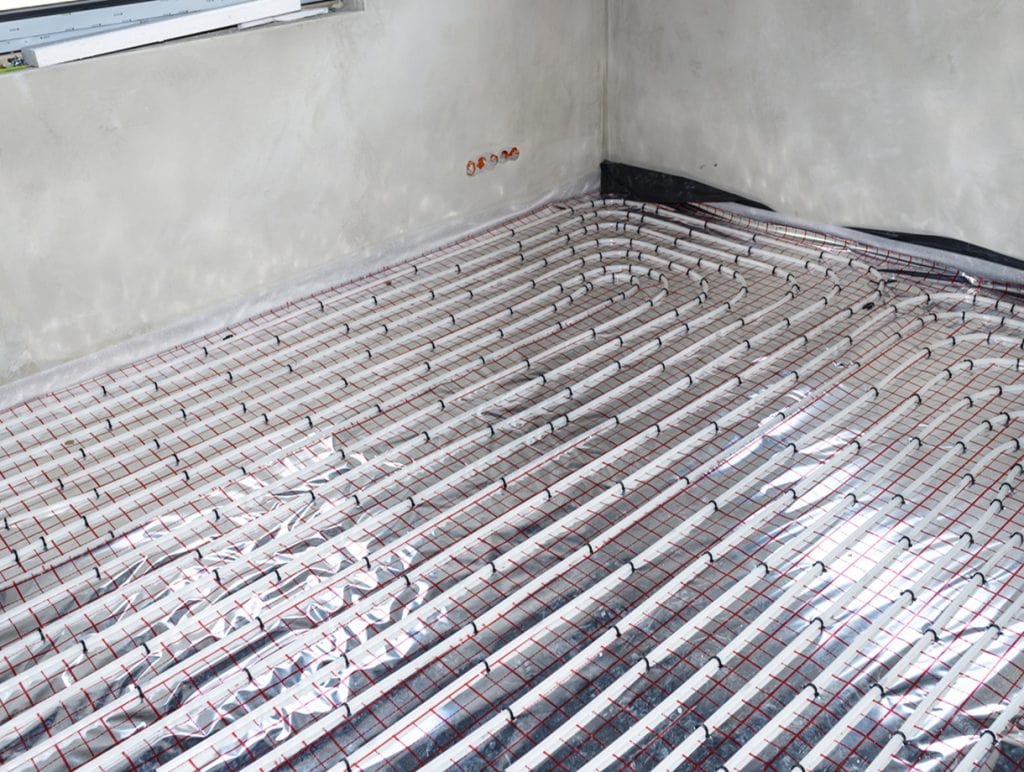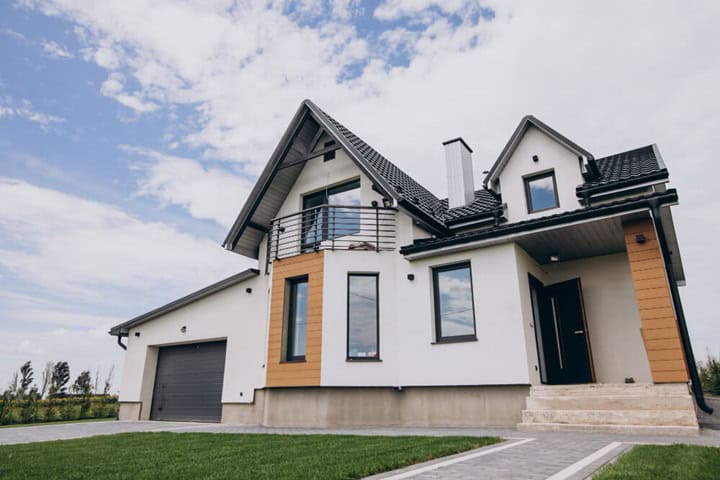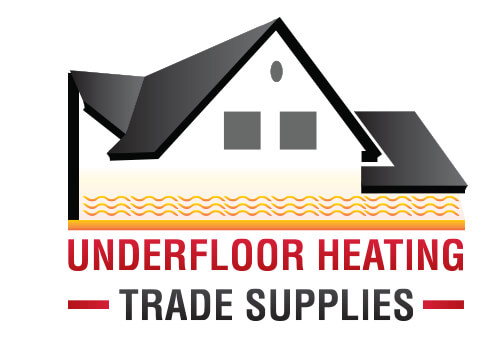
Tired of stuffy, overheated rooms in summer—but don’t want bulky air con units ruining your space? There’s a quieter, more discreet way to cool your home.
Underfloor cooling is a clever alternative that works with your existing underfloor heating system to provide year-round comfort. In this article, we’ll explain how underfloor heating and cooling systems work, what makes them efficient, and how they compare to traditional options like air conditioning, heating pumps, and central heating systems. Whether you’re building new or upgrading, here’s what you need to know.
Key Points:
- Underfloor cooling uses chilled water to absorb heat and lower room temperature
- It works with the same system used for underfloor heating
- Best paired with hard flooring and a reversible heat pump
- Offers quiet, even cooling with no visible units or airflow
- Ideal for homes, offices, and renovation projects looking for energy savings year-round
A Flexible Solution for Year-Round Comfort
When it comes to modern climate control, few systems offer the flexibility of underfloor heating and cooling. These floor-integrated systems not only provide warmth in the winter but can also help maintain a comfortable indoor base temperature during warmer months—all without the need for visible vents or noisy fans.
Whether used in homes, offices, or renovation projects, underfloor cooling is becoming an increasingly popular choice thanks to its efficiency, simplicity, and ability to support clean interior designs. Unlike traditional air conditioning, which blows and circulates cold air around the room, this method works quietly in the background.
How Underfloor Heating and Cooling Systems Work
The technology behind underfloor heating and cooling is simple but smart. In winter, warm water circulates through pipes laid beneath the floor, turning the entire surface into a gentle heat source. This radiant floor heating rises evenly, creating a cosy atmosphere without hotspots or draughts.
In summer, the process reverses. Instead of heating water, the system sends chilled water through the same pipe loops. As the cooler surface absorbs heat from the room above, it lowers the air temperature naturally—without any loud fans or dry air.
This radiant method is much more comfortable than standard systems that rely on blowing cold or warm air into a room. Plus, it avoids the dust circulation you often get with radiators or air con units.
Designed for Efficiency and Style
One of the biggest advantages of underfloor heating and cooling is that it’s completely hidden from view. There are no bulky radiators or ducts to work around, which gives homeowners and architects total freedom when it comes to room layout and interior design. Of course, it is possible for underfloor heating and radiators to work together.
Because the floor has a large surface area, it doesn’t need to be as warm—or as cold—as a smaller heat source. This means the system can run at lower temperatures, using less energy and keeping running costs down.
It also works extremely well with renewable energy setups. When paired with a heat pump, for example, the system becomes even more efficient, using low-carbon energy to deliver heating in winter and passive cooling in summer.
A Smart Choice for New and Old Properties

Underfloor heating and cooling systems are suitable for both new builds and old properties. Thanks to low profile underfloor heating, these systems can be retrofitted without raising floor levels too much—making them ideal for modernising older properties.
Installers appreciate the ease that comes with fitting these particular underfloor heating systems, as well as their proven reliability, while homeowners can enjoy quiet, consistent comfort all year round.
Underfloor Cooling vs Air Conditioning
When thinking about ways to cool a space, air conditioning might be the first option that comes to mind. But underfloor cooling works very differently—and while it doesn’t replace air conditioning entirely, it offers a quieter, more energy-efficient way to reduce indoor temperatures.
Air conditioning actively cools the air, often dropping the temperature by up to 15°C. It does this by circulating chilled air throughout the room. Underfloor cooling, however, works by circulating cool water through floor pipes, which then absorb warmth from the room. This can reduce room temperatures by around 3–5°C compared to an uncooled space—just enough to take the edge off in warmer months.
Planning and Designing an Underfloor Cooling System
The performance of underfloor cooling depends heavily on how well the system is planned. If the layout, including the underfloor heating pipe spacing, and water flow aren’t correctly set up, you might not get the cooling effect you’re expecting.
One key consideration is the flow rate. In well-insulated buildings, underfloor heating and cooling systems need slightly higher water flows during the cooling phase to ensure enough heat is removed from the room. This means pipe circuits must be planned to support both winter and summer performance. Heating flow temperatures are typically lower in a cooling setup, so circuits should be designed with that in mind.
Pipe spacing also plays a big role. For systems designed only for underfloor heating, pipe distances of 150–200 mm are common. But for combined underfloor heating and cooling, tighter spacing—around 100–150 mm—is usually better. This allows for more even coverage and improves the system’s ability to absorb heat in warmer months.
Getting the Right Controls in Place
Controls are just as important as design. A common problem with underfloor heating and underfloor cooling is condensation on the floor. To avoid this, you need to make sure the cooling water temperature stays above the dew point. That’s where humidity sensors come in.
In many systems, these sensors are installed on the manifold in technical rooms. But these rooms are often warmer and more humid, which can trigger the system to shut off cooling earlier than it should.
A better approach is to use floor sensors in each room. With the right wiring centre, for example, you can set a minimum floor surface temperature—usually around 18 to 20°C—which helps prevent condensation and gives you better control of each zone.
Underfloor Cooling on Different Floors
For adding underfloor heating and cooling on different floor types, use this table including underfloor heating on parquet floors:
| Glued Laying Solid Parquet Flooring | |||
| Thickness | Width (m2) | Wet Underfloor Heating | Heating/cooling underfloor |
| 10 | 50/60/70 | Yes | Yes |
| 14 | 70/90/110/130 | Yes | Yes |
| 20 | 90/140 | Yes | No |
| 20 | 160/180/200 | No | No |
| 23 | 50/60/70/90/120 | Yes | No |
| Glued Laying Engineered Parquet Flooring | ||||
| Support | Thickness | Width | Wet Underfloor Heating | Heating/cooling underfloor |
| Loft Pro | 12 | 90/120/145/180 | Yes | Yes |
| 15 | 86/90/145/180/220 | Yes | Yes | |
| 16 | 90/130/145/180/220 | Yes | Yes | |
| Loft | 20 | 180/225 | No | No |
| 14 | 155/180/190 | Yes | No | |
| Floating Laying Engineered Parquet Flooring | ||||
| Support | Thickness | Width | Wet Underfloor Heating | Heating/cooling underfloor |
| Loft Pro | 12 | 90/120/145/180 | Yes | No |
| 15 | 86/90/145/180 | Yes | No | |
| 16 | 90/130/145/180/220 | Yes | No | |
| Loft | 20 | 180/225 | No | No |
| 14 | 155/180/190 | Yes | No | |
Installing a Low-Temperature Underfloor Heating and Cooling System
Low-temperature systems are ideal for both underfloor heating and cooling, offering a balanced way to regulate indoor temperatures throughout the year. Whether you’re using a wet underfloor heating system, or electric underfloor heating, careful planning and proper installation can bring long-term comfort and system performance.
Pro Tip: Consider the cumulative thermal resistance of the floor layers—this includes the vapour barrier, any underlay, and the final flooring. The total R-value should not exceed 0.15 m²K/W to ensure efficient heat or cool transfer.
Hydraulic Underfloor Heating
Hydraulic underfloor heating is the most common type used in underfloor heating and cooling systems. It involves pipes laid over insulation, which are then embedded in a concrete screed. The screed helps to distribute heat or coolness evenly across the floor surface.
Key installation requirements:
- Fluid temperature should not exceed 40°C
- Finished floor surface should remain below 28°C
- Designed according to EN 1264-1:2021 standards for floor heating systems
- Screed must fully cover the pipework for safe and effective heat distribution
In cooling mode, the same system is used but with cool water instead. This turns the floor into a large radiant surface that absorbs heat from the room, lowering the air temperature by 3 to 5°C.
Electric Underfloor Heating
Electric underfloor heating uses heated wires spread across the subfloor. Like the hydraulic version, these are usually covered by a screed or slab.
Important points to note:
- Finished floor temperature must remain below 28°C
- The screed covering should be no more than 6 cm thick
- Always check with your supplier if this system is compatible with your chosen floor type (especially wood)
Please note: Unlike hydraulic systems, electric underfloor heating systems cannot be used for underfloor cooling.
Installation Precautions and Best Practice

Before installing flooring:
- Make sure surface temperatures don’t exceed 28°C
- Avoid placing thick rugs or carpets over heated floors—they can trap heat and cause system faults.
Start-up process:
- Begin heating the screed four weeks before installing the flooring
- Turn off the system 48 hours before floor installation
- After installation, gradually restart heating by increasing temperature by about 5°C per day
Adding a control system helps manage these temperature changes smoothly, protecting both the floor and the system.
In conclusion, underfloor heating and cooling systems offer a practical way to maintain comfortable temperatures all year round. While underfloor cooling has its limitations (like any other heating system), especially compared to air conditioning, it’s a quiet, low-maintenance option that works well when properly planned and installed. With the right controls, insulation, and system design, you can enjoy efficient heating in winter and gentle cooling in summer—without the clutter or noise of traditional systems – a smart choice for modern living.
Further reading:
Based on the topics discussed in this article, here are some further knowledgeable guides provided by us to assist your underfloor cooling experience –
FAQs
Can any underfloor heating system be used for cooling?
Not always. Only certain wet (hydronic) underfloor heating systems can be adapted for cooling — usually when paired with a reversible heat pump. Electric underfloor systems cannot provide cooling.
Does underfloor cooling cause condensation on the floor?
If properly designed, no. The system must maintain water temperatures above the dew point to prevent condensation forming on the floor surface.
What types of flooring work best with underfloor cooling?
Hard, conductive surfaces like stone, tile, or polished concrete work best because they efficiently transfer cool air into the room. Carpet or thick wood can reduce cooling performance.
Sources
Bailes, A.A. III, PhD., (2014) Choosing a Base Temperature for Degree Days. Green Building Advisor. [online] Available at: https://www.greenbuildingadvisor.com/article/choosing-a-base-temperature-for-degree-days [accessed 14/05/2025]
